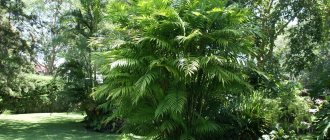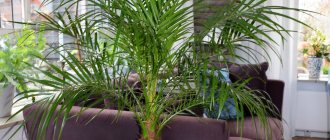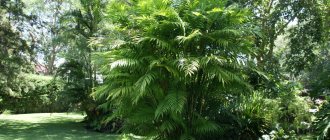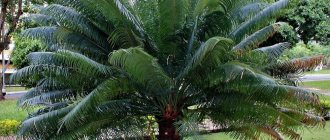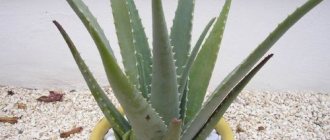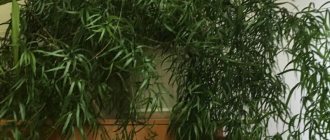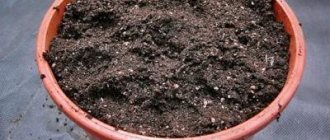Chamaedorea is known among indoor plant lovers as the bamboo palm.
It got its name from its leaves and thin trunks, similar to bamboo. Another name for the palm is mountain palm, received because in nature this plant can only be found in the mountainous areas of South and Central America.
Botany describes about a hundred species of palm trees; they grow in tropical and subtropical climates, with high humidity and temperature.
The plant prefers shady places, mainly at the foot of tall trees.
The choice is yours
There are several types of plants that differ significantly in external characteristics.
Chamaedorea elegans is usually grown at home. The second name of this pinnate palm with long lanceolate leaves is Neanta.
In the photo, chamedorea graceful
This species grows slowly, producing 2-3 pairs of leaves per year, begins to bloom early, and when mature the plant reaches a height of 2 meters.
Chamaedorea elatior is also popular - another type of mountain palm, but in appearance it is very different from Chamaedorea graceful with wide leaves coming from a thin trunk.
The trunk has ring-shaped marks from fallen leaves. The flowers of this palm are orange, collected in a panicle inflorescence.
Hamedorea Ernest-Augustus and metallic are similar to each other with wide, forked leaves that are pointed at the ends.
Both have a thin single trunk, but the leaves of the metallic palm stand out with the special color and shine that gives the palm its name.
Indoor palm tree photo and name
The palm genus has many varieties. Only certain species are grown indoors. Tropical palms differ in shape and are unpretentious. More often, gardeners grow cat palm, Asian palm, Rhopalostis, Washingtonia, Gioforba, Brachea, etc.
Areca
Areca is a plant with thin cylinders emerging from a tubular base. The leaves are pinnately dissected. The inflorescences are shaped like cobs, with male staminate flowers at the top and female pistillate flowers at the bottom.
Areca bears fibrous berries from which seeds are extracted.
Brachea
Brachea is an evergreen palm with fan-shaped leaves. Toward the bottom, the base of the trunk thickens and can reach a diameter of 50 cm.
Scars appear on its surface below, which form after the foliage withers.
The leaves are hard, located in the upper part of the trunk, have a bluish-gray color and thin petioles covered with thorns. During the flowering period, many inflorescences are formed on the palm tree, the length of which reaches about 1 meter. They fall from the top of the tree to the ground. The fruits are round, single-seeded, brown in color. Their diameter is no more than 2 cm.
Bhutia
Butia is distinguished by petioles that are shaped like arcs. They can reach from 2 to 4 m in length. Each leaf contains 80-100 pairs of narrow lobes, shaped like swords. Their length reaches 75 cm. The upper part of the leaves is bluish-green, the lower part is slightly paler. The petioles are covered with thick felt in young palm trees. In mature plants, the felt turns into small spines.
After the leaf blades die, brown stumps remain on the trunks. After the stumps fall, peculiar scars remain on the trunk.
Butia blooms at the end of spring, releasing spike-shaped panicles from the axil of the upper leaf.
The length of the inflorescence is 1.4 m. The flowers are light red. The fruits are oval-shaped and have a fragrant aroma. Ripens at the end of September. The fruits are edible, suitable for canning, for making liqueurs and jellies, and eaten raw.
Kariota
Kariota stands out among other types of palm trees due to its non-standard leaves. They are large and asymmetrical.
The palm tree is an evergreen species. In nature, its height can reach 20 m, but when grown at home - from 1 to 2 m.
Karyote can be tree-like or grow in the form of a bush. The leaf blades are double pinnate, in the form of original wide feathers of irregular triangular shape. The top of the leaf blades appears to be torn off. Their edges are unevenly jagged. The foliage appears light and airy thanks to the long petioles.
Kariota does not bloom at home.
Washingtonia
The Washingtonia palm genus belongs to the Arecaceae family. In nature it grows up to 25 m with a trunk up to 100 cm in diameter. Fan-shaped leaf plates grow at the top of the plant. The length of the cutting, covered with thorns directed in different directions from the trunk, is 1.5 m. It rarely blooms when grown indoors.
Washingtonia leaf fibers are used to weave baskets. The fruits are suitable for making flour. Washingtonia needs coolness and plenty of space.
It is rarely grown at home, as it increases significantly in size and requires planting in open ground.
Giophorba
The palm tree is distinguished by its unusually shaped trunk in the form of a vessel. The surface of the trunk is smooth, thickening in the middle. The narrow part of the trunk can reach 15 cm in diameter, and the wide part - 40 cm. The height of the tree does not exceed 1.5 m.
The foliage is bright green, fan-shaped, pinnate. It consists of 30-40 pairs of leaves, which are shaped like feathers. Their length is no more than 40 cm.
Hovea
When grown indoors, Howea grows up to 3 m. It produces no more than 3 leaves throughout the year. In nature it grows up to 15 m. The plant is single-stemmed. The upper part is formed by stems with dissected, pinnate leaves. It forms many basal shoots, which are later united into a common trunk.
Zamia
Indoor Zamia palms are evergreens. They grow small. The trunk is smooth. Most of it is located underground. It is distinguished by a tuberous elongated shape. The pinnate leaves are alternately arranged on long stalks, but are not particularly dense. The petioles are occasionally covered with spines. The leaves themselves are hard, dense, divided into several parts. They are distinguished by their lanceolate shape and jagged edge.
Liviston
This variety grows up to 25-40 cm. It is classified as slow-growing. The trunk is gradually covered with dried petioles, which remain after the foliage withers and further dies.
The crown is formed from fan leaves at the top and has a rounded shape. The leaves are dissected to the middle. The formed parts of the leaf plate are radially folded. The length of the petioles is no more than 0.2 m. Inflorescences are formed in the axils under favorable conditions.
When grown indoors, this type of palm tree does not develop a trunk.
Likyala
This is a dwarf palm. In its appearance, this flower bears little resemblance to a palm tree. In nature, the height of the plant does not exceed 3 m. Large Likuala is grown by flower growers. It features beautiful pleated leaves. The leaf blades are round, bright green, and resemble fans. The width of the leaves of an adult plant is up to 1 m.
The leaves of this variety are used in making hats.
Good to read: Croton is a capricious beauty with extraordinary foliage.
Has a thin trunk. The fruits are large in size and hang in clusters. When grown indoors there is virtually no color.
Rapis
Among the palm trees for the home, Rapis is distinguished. Flower growers grow two varieties. Usually this is Rapis low. It stands out for its unique appearance and small size. Grows up to 1.5 m.
The second variety, Rapis tall, is grown for large areas: greenhouses, supermarkets. Grows up to 3 m.
Ropalostylis
This palm tree has a slender trunk. After the leaves fall, rings form on the trunk. Belongs to fruit-bearing species. The fruits are small, round in shape, red in color. Mature plants can be 10 to 12 m tall. Flower growers grow this variety only when young.
Important to know: The fruits of Chinese lemongrass have tonic properties and are very beneficial for the human body.
Sabal
The Sabal palm genus has 16 varieties. In the wild it grows up to 30 m with a trunk diameter of up to 0.6 m. The foliage is fan-shaped, evergreen, supported by strong petioles.
Trachycarpus
In nature, a palm tree of this species can grow up to 20 m. Its trunk is covered with fibers of dead leaves. When grown indoors, the height of the plant does not exceed 2.5 m.
The leaf blades have an oblong, round shape. They can reach 60 cm in diameter. The petioles of the leaves are long, covered with spines. The leaf plate is divided into segments. There is a pale bluish coating on the reverse surface.
The inflorescences are racemose and consist of female flowers. In plants grown in winter gardens and greenhouses, after flowering, clusters with fruits resembling grapes are formed.
Trachycarpus does not bloom when grown indoors.
Good reading: Flowering indoor plants: catalog with photos and names, recommendations for growing.
Date
In the wild, the date palm reaches 30 m. Its fruits, dates, have a sweet taste.
Therefore, the date palm is grown on an industrial scale. Sugar is made from the sap of the plant.
Its distinctive feature is its slow growth. With proper care at home, the date palm grows up to 2 m, but grows very wide. Culture requires a room with high ceilings and a large area. The leaf blades are pinnate. Palm leaves are the main decoration of the plant. The inflorescences consist of yellow buds. The photo of these domestic palm trees is striking in its unusualness.
In indoor conditions, the date palm practically does not bloom and does not bear fruit. The plant produces its first fruits after reaching a height of 15 m. This is impossible at home.
Hamedorea
A bush variety of Hamedorea is grown at home. There is a palm tree in the form of a vine or bush with one stem. It grows slowly. It produces 1-2 leaves during the year. Plants can be female or male. The main difference is the inflorescences. Female buds are orange or deep red, single, male buds are red or yellow, collected in inflorescences. Plant grown indoors will not bloom.
Hamerops
The genus of this plant is represented by only one species. The tree grows up to 4-6 m. It blooms in April, May, June. The Hamerops palm plant is distinguished by its spiny petioles and massive trunk. The leaves resemble fans.
Read about which plants are similar in appearance to palm trees here.
Buying a plant
Hamedorea can be found in flower shops - often it is a small bush with many basal shoots. It is difficult to find a large palm tree because it grows slowly and is therefore very expensive.
When choosing a plant, you need to pay attention to the leaves - they should not be dull, dried out or brown at the ends. A new plant brought home should be left to rest for several days so that it gets used to the new environment.
After 7-10 days it will be possible to start dividing the bush and replanting.
Signs and chamedorea
Domestic chamedorea has been in culture for more than one century, and during this time many legends, signs and superstitions associated with it have accumulated. The question of whether it is possible to keep it at home quite reasonably arises when purchasing it, because the relationship between man and plant exists.
In the 80s of the 20th century, NASA conducted special studies on the impact of plants on the environment. It turned out that the indoor palm tree purifies the air from formaldehyde, trichlorethylene, and benzene and occupies one of the leading positions among houseplants capable of purifying the air of impurities.
Folk signs about chamedorea:
- in a family or office space where there is a palm tree, conflict situations arise less frequently;
- good luck accompanies its owner;
- scares away energy vampires;
- prevents the spread of negative energy in the room;
- if the leaves are light, then there is harmony in the house; if the leaves begin to darken, it means that a lot of negativity has accumulated, or there is evil spirits in the house.
Planting process
To plant chamedorea, you need to select developed sprouts with their own root system, fresh leaves and strong stems.
Soil is poured into a small pot. You can use the soil you prepared yourself or buy a composition in the store that will include all the necessary ingredients.
Hamedorea palm seedlings
For palm trees, the best solution is a mixture of equal parts of turf, peat and humus, with the addition of half of clean river sand.
Leaf and coniferous soil are also suitable for growing palm trees. The mixture should be light, water- and breathable - for this effect you can supplement the earthen composition with vermiculite, coal or coconut shell shavings.
1.Seven secrets of success:
| 1. Growing temperature: in spring and summer, when Hamedorea is actively developing, it needs warm conditions - keep palm trees at an air temperature ranging from 18 to 24 degrees Celsius. During the winter months, it is better to provide a cool rest period at a temperature of 13 - 15 degrees Celsius. |
| 2. Lighting: shading from direct rays of the sun only during the daytime - plants can sunbathe in the morning and evening. If there is a lack of natural light, chamedorrhea develops well under artificial light. |
| 3. Watering and air humidity: with soft water at room temperature, water in such a way that between waterings the top layer of soil 2-4 cm thick dries slightly in spring and summer. In autumn and winter, reduce the frequency of watering to a minimum, just trying not to dry out the earthen ball. Air humidity is high. |
| 4. Pruning: Palm trees only need sanitary pruning, which involves removing all old and diseased leaves. To ensure that the palm tree does not waste its energy on flowering and fruiting, the flower stalks that have just appeared are cut off. |
| 5. Soil: loose, well-drained, nutritious substrate with a neutral or slightly acidic pH. |
| 6. Feeding: from spring to autumn, regular feeding with mineral liquid fertilizers for palm trees or ornamental foliage plants every 2 weeks. In mid-autumn, subcortical growth is stopped and resumed only in the spring, with the appearance of the first signs of new growth. |
| 7. Reproduction: by sowing seeds in spring or dividing large specimens during transplantation, by root shoots in spring and summer. |
Botanical name: Chamaedorea.
Hamedorea domestica - family
Homeland of the plant. Mexico, Guatemala.
Description. An evergreen low palm with several thin, graceful trunks.
The crown is formed by lush, feathery, complex leaves up to 60 cm long, consisting of many alternately arranged narrow-lanceolate segments.
The leaf segments are glossy, green, 10–15 cm long, with longitudinal parallel veins. The edges of the leaf segments may be forked in some varieties.
The inflorescences are branched, drooping or erect, and consist of numerous yellow flowers. There are male and female flowers on different plants - that is, these palms are dioecious plants.
Female palms produce small, round fruits after flowering.
In some species of chamedorea, aerial roots may appear in the lower part of the trunk with age.
The second name is bamboo palm, the plant received the external resemblance of its thin, graceful stems to bamboo shoots.
Height. The Hamedorea palm tree grows slowly at home and in potted plants often does not exceed 1 m.
In their natural habitat, these trees can grow up to 5 m in height.
There are miniature varieties, the height of which, when grown in pots, reaches only a few tens of centimeters.
Features of care
The Hamedorea palm tree is valued not only for its appearance, but also for its unpretentiousness in terms of maintenance and care.
Despite its tropical origin, the palm tree feels good at temperatures from 12 degrees, the optimal option is 16-20 degrees.
The palm tree does not like direct sunlight, so it is necessary to place the flower pots in partial shade or shade, near western, eastern and northern windows.
You cannot place the plant on a cold floor - cold promotes the development of root diseases. To avoid this, you can place the pot on a stool or a special stand.
The plant should be watered as the top layer of soil dries out and the higher the air temperature, the more water is needed; it is advisable to spray the leaves or rinse them with warm water in the shower.
The water needs to be settled and warmed to room temperature. There is no need to fertilize young bushes transplanted into fresh soil.
Adult plants are fertilized with compounds for palm trees or universal complexes.
Botanical description
Chamaedorea (lat. Chamaedorea) or Mountain palm is a genus of flowering plants from the Palm family , numbering over 130 species. Distribution area: Central and South America, Mexico.
Distinctive features:
- the height of the bush is 1-2 meters;
- the trunk is straight, thin, bamboo-shaped, most often ringed, with a large number of shoots;
- the leaves are wide, simple or pinnate at the apex, often directed downward from the base;
- the inflorescence can be either simple or in the form of a panicle;
- The flowers of the mountain palm are small, their color varies from yellow to bright red;
- At the end of flowering, the flowers form black berries.
It is noteworthy that unopened male inflorescences are used for food by local residents.
Some varieties of the plant are suitable for growing indoors, and some are able to bloom with artificial pollination and produce seeds.
Care according to the calendar
Depending on the time of year, there are some care features:
- In summer, the palm tree is taken out onto the balcony, slightly shaded. Watering is provided abundantly, using fertilizers once every two weeks. The crown needs to be sprayed and the leaves wiped clean from dust. Once a week you should turn the pot 180 degrees so that the crown grows evenly.
- In the fall , the plant is brought indoors and the plant is watered less frequently. In the northern regions, where daylight hours are sharply reduced, you can install a phytolamp for the palm tree.
- In winter , the plant should be protected from drafts, watering should be reduced to once every 10-14 days, and fertilizing should be reduced to once a month.
- In the spring, young palm trees are replanted or reloaded with new soil and a larger pot, watering is increased more often and the plant fertilization regime is changed.
Hamedorea flowers are not decorative and are usually removed immediately, but if you want to save them and get seeds, then during the flowering period you can change fertilizers using special ones intended for flowering plants.
You need to be more careful about watering, and do not allow water to get on the flowers during spraying.
Video on how to care for chamedorea at home:
Watering
Those wishing to have chamedorea also need to familiarize themselves with how to water the flower. In summer, chamedorea requires more abundant watering. The soil should not be allowed to dry out completely. In summer, the plant is usually watered 2 times a week.
But it is important to know that overwatering is dangerous for chamedorea and can cause root rot. In addition, chamedorea loves spraying and you can periodically give it a shower.
In winter, watering should be done approximately once a week after the soil dries out.
Plant propagation is not easy, but it is possible
Hamedorea can be propagated by dividing the bush, by root shoots or by seeds.
The bush can be divided when transplanting, carefully separating part of the palm roots, which will be transferred to a new pot. Propagating a palm tree using root shoots is even easier and safer for the plant, since palm trees do not like their root system being disturbed.
Sprouts 4-6 cm high are separated from the bush and planted separately, provided that the sprouts have their own developed roots.
With bright diffused lighting, constant high humidity and warmth, plants take root in 1-2 months. Sprouts that have taken root and become stronger are transplanted after 4 months to a permanent place.
Care must be taken to ensure that the roots do not remain exposed - this can lead to the death of the plant.
Reproduction of Hamedorea by dividing the bush
Use of seed material
Hamedorea also reproduces by seeds and planting material is easy to obtain at home if you do not remove the inflorescences, but treat them, transferring pollen with a soft brush from male flowers to female ones.
Ripe or store-bought seeds are sown in March or April ; you should not delay planting, since the seeds lose their viability quickly and, if they are more than a year old, they are unlikely to germinate at all.
The seeds are soaked for 5 days, the thick shell is scratched, placed in moist soil and the temperature is maintained at 25-27 degrees. Seeds germinate in 35-45 days.
To maintain the level of humidity and temperature, cover the box with seedlings with transparent polyethylene or glass, remembering to ventilate the plantings once a day. With the appearance of the first leaf, the sprouts are transferred to separate pots.
Reproduction of Hamedorea palm
Mountain palm has an excellent ability to reproduce by vegetative and seed methods.
- Vegetative propagation occurs through root shoots. You can separate it when you already have your own formed roots.
- Palm seeds can be purchased at a garden store and immediately planted in prepared soil. To speed up the germination of seeds, a greenhouse effect is created - after sowing, the soil is slightly moistened and covered with film. The temperature should be kept at 25-28°C with ventilation for 5-10 minutes. Then the sprouts are planted 3-4 per pot, to better ensure that the plant will take root.
Advice! After purchasing seeds, you need to immediately start sowing chamedorea, since their germination capacity is lost over time.
Time and features of transplantation
Flower growers usually transplant Hamedorea in late spring. Plants purchased in stores also require replanting - in this
In this case, it can be done at any time of the year.
Young palm trees are replanted once a year, and adult large plants once every two to three years, when the roots begin to occupy all the free space in the pots and come out through the drainage holes.
For each transplant, the pot should be wider than the previous one by 2-3 cm in diameter and higher. It is necessary to lay drainage made of expanded clay, small broken bricks or ceramic fragments at the bottom.
This will help remove excess water, preventing acidification of the soil and the development of infections that affect plant roots.
When replanting annually, you do not need to remove all the soil from the roots of the plant and trim them - the palm trees are simply transferred to a new pot.
The roots of plants bought in stores can be cleaned, but only a little.
The rhizomes of diseased plants require high-quality treatment; you need to wash them in water, remove shoots affected by rot, treat them with special means and sprinkle them with coal.
After this, the roots are carefully straightened and sprinkled with earth, lightly pressing it around the trunk.
Pest and disease control
Chamedorea faces the same problems as other palms. Yellowish-white spots on the leaves may be a symptom of thrips. Scale insects readily attach themselves to the shoots, and spider mites leave a whitish web.
The first step is to get rid of pests as much as possible mechanically and wipe the plant with soapy water. And after that, use homemade insecticides for indoor plants.
If the trunk becomes covered with putrefactive spots at the base or the shoots fade and die, this is a fungus. If the lesion is very small, use fungicides and adjust care. If the situation is irreversible, it is better to immediately destroy the plant and not spread the infection.
In addition, there are fungi that attack the leaves. For example, with anthracnose they become covered with small raised spots that gradually grow. In this case, get rid of the diseased leaves, temporarily stop spraying, lower the air humidity and use medicinal drugs.
Photo: domashniecvety.ru
Pedilanthus (60 photos): types, cultivation and care at home
Care problems
Despite the fact that the chamedorea palm tree does not have any special care requirements, problems still occur when growing the plant at home - one of the most common is drying out and yellowing of the tips of the leaves.
This indicates a lack of moisture - the palm tree needs to be watered more and its leaves need to be sprayed.
In species of Chamedorea tall, Ernest - Augusta and others with a single trunk, drying of the lower leaves is the norm, especially if new ones grow at the same time.
Drying of young leaves, their grayness and withering mean problems with the root system, its rotting. You can save the plant by transplanting it into a new pot, smaller in size with a looser substrate.
Sometimes brown spots may appear on the leaves - this is the result of sudden changes in temperature, draft or improper care of the leaves.
To solve the problem, it is enough to move the chamedorea to a warm place, and wipe the leaves with a damp soft cloth, without any additional means, and spray regularly.
The plant is on the verge of death
Why does chamedorea dry out and the leaves turn yellow?
The cause of the plant's painful condition is improper care. If the leaves turn yellow after transplantation, this is a temporary phenomenon. The lower leaves of the palm tree turn yellow and die - a natural process of changing leaf apparatus.
If the leaves dry out en masse, the air has low humidity; if only the tips dry out, you need to reduce watering. The same measures are taken if the plant looks lethargic and the leaves turn black and die. It would be a good idea to check the roots for rot.
Dry brown spots are traces of sunburn; the lighting needs to be adjusted.
Cats love palm trees. The plant is protected by sprinkling with lemon juice. You can put a few lemon peels in the pot, which change over time.
How does chamedorea reproduce?
There are several options for propagating this palm tree. This fact in itself indicates a high probability of success in each case.
Germination of seeds
Reproduction of chamedorea by seeds is usually carried out when an adult fruit-bearing tree is freely available (more precisely, several trees, since the species is dioecious). The seeds lose their germination very quickly, literally every month (the maximum shelf life is 10 months), so they are sown immediately after collection.
Hamedorea seed sprout
Before sowing, the seeds are soaked in water for 5-6 days after scarification (each seed is slightly filed with a grindstone). You need to plant in 100 g cups filled with a mixture of peat and sand. There is no need to bury the seed, but it should be watered and covered with a cap to create a greenhouse effect.
Optimal germination temperature: +22..+25 °C. The freshest seeds will sprout in 2 months, and those that are on the verge of expiration date will sprout only after 6-8 months. The sprout should be transplanted into a new container when its leaf grows to a length of 4 cm.
Rooting cuttings
This technique is suitable only for those types of chamedorea in which the crown is formed in the form of a bush of several trunks. Any of the root shoots of an adult (over 3 years old) palm tree can be carefully separated and immediately planted in a mixture of peat and sand.
Rooting several cuttings at once
Air layering
In a bush with several trunks, one of the shoots is bent down to a nearby pot of soil. A small cut is made on the bottom side and smeared with Kornevin or cytokine paste. The notch site is immersed in the soil and secured with a pin.
If everything goes well, roots will appear on the shoot within 2-3 months, after which the shoot can be cut off from the mother plant.
Other options
Hamedorrhea is usually divided at the time of replanting. The roots are washed from the soil under running water and carefully separated into parts. Then each part should be transplanted into a pot filled with fresh soil.
Several seedlings resulting from dividing the bush
